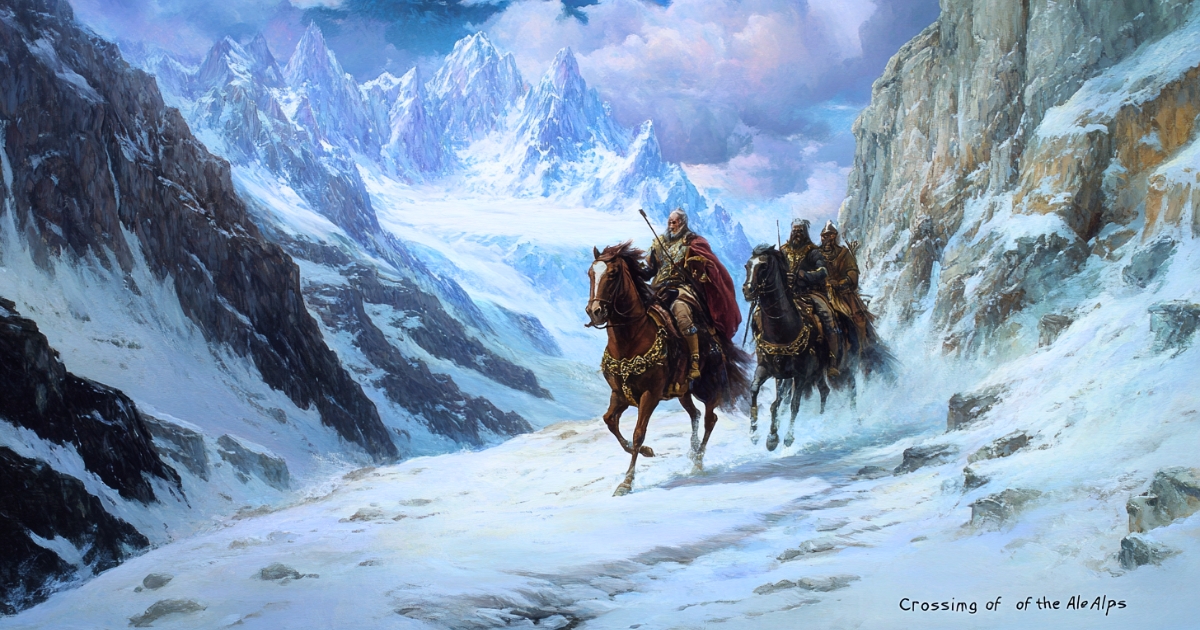Introduction
The “Crossing of the Alps” executed by Hannibal, the Carthaginian general, in 218 BCE is known as one of the most daring and difficult operations in ancient military history. This operation was conducted in the early stages of the Second Punic War and was part of a surprise attack against the Roman Empire. This article will explain the details of Hannibal’s Alpine crossing operation and consider its military significance and influence on future generations.
Background: The Outbreak of the Second Punic War
In 218 BCE, the Second Punic War broke out between Carthage and Rome. This war was a fierce struggle between the two great powers for hegemony over the Mediterranean. Hannibal Barca, renowned as the commander of the Carthaginian side, devised a bold strategy to directly attack mainland Rome. The core of this plan was an unprecedented operation to invade the Italian peninsula by crossing the Alps.
Formation and Departure of the Army
Hannibal organized a large army consisting of about 50,000 infantry, 9,000 cavalry, and 37 elephants. This army included not only Carthaginians but also mercenaries gathered from the Iberian Peninsula and North Africa. In the spring of 218 BCE, Hannibal departed from Carthago Nova (present-day Cartagena) in eastern Spain and began moving northward.
Crossing the Pyrenees
The first major obstacle was the Pyrenees, which separate the Iberian Peninsula from Gaul (present-day France). Here, Hannibal advanced cautiously to avoid conflict with local Celtic tribes. At this stage, about 10,000 soldiers deserted or returned, but Hannibal continued to advance with the remaining army.
Crossing the Rhone River
Upon entering Gaul, Hannibal’s army faced the challenge of crossing the Rhone River. This required negotiations with local Gallic tribes and devising ways to cross the rapid current. Hannibal’s ingenuity shone through in creating special rafts to transport the elephants across.
Beginning the Alpine Crossing
At the end of September 218 BCE, Hannibal’s army finally reached the foot of the Alps. This marked the beginning of the most difficult part of the operation. An unprecedented challenge began: crossing steep mountainous terrain with a heavily equipped army and elephants.
Difficulties of the Alpine Crossing
During the Alpine crossing, Hannibal’s army faced numerous difficulties:
- Harsh climate: Despite it being late September, the mountainous areas were hit by snow and ice.
- Treacherous terrain: Narrow mountain paths and steep slopes significantly slowed the army’s advance.
- Food shortages: Procuring food was difficult at high altitudes, and soldiers suffered from hunger.
- Attacks by local tribes: Some mountain tribes attacked Hannibal’s army.
- Handling elephants: Maneuvering elephants on mountain paths was extremely difficult, and many elephants died.
These difficulties caused significant losses to Hannibal’s army. Records suggest that less than half of the initial force completed the Alpine crossing.
Arrival in Italy and Its Impact
After 15 days of arduous marching, Hannibal’s army finally reached the plains of northern Italy in October 218 BCE. This unexpected invasion shocked Rome. In the following years, Hannibal repeatedly defeated Roman armies throughout the Italian peninsula, threatening the survival of the Roman Empire.
Particularly famous is the Battle of Cannae in 216 BCE. In this battle, Hannibal overwhelmingly defeated a numerically superior Roman army, achieving the largest encirclement and annihilation battle in ancient history.
Influence on Military History and Lessons Learned
Hannibal’s Alpine crossing operation had a significant impact on military history:
- Importance of surprise attacks: It demonstrated how effective attacks from unexpected routes can be.
- Logistical challenges: It highlighted the importance of supply in long-distance expeditions.
- Importance of leadership: Hannibal’s command ability was essential in leading the army under difficult conditions.
- Need for adaptability: Flexibility in responding to unexpected difficulties was key to the operation’s success.
Conclusion
Hannibal’s Alpine crossing operation continues to be recounted to this day as one of the most daring and difficult operations in ancient military history. This operation was made possible by meticulous planning, excellent leadership, and the incredible endurance of the soldiers. Although Carthage ultimately lost the Second Punic War, Hannibal’s military talent and strategic thinking continue to influence military leaders of later generations.
The Alpine crossing operation is still highly regarded today as a symbol of human ability to make the impossible possible, and as a military lesson demonstrating the effectiveness of attacks from unexpected directions. This historical feat is a valuable example that teaches us the importance of courage and ingenuity in facing difficulties.


